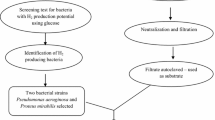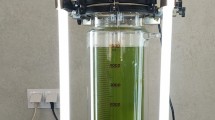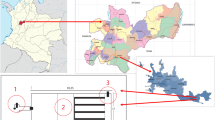Abstract
Water samples from the Kuwaiti coasts of the Arabian Gulf were used for counting and isolating bacteria capable of growth on low molecular weight organic compounds known to be released by picocyanobacteria. The compounds tested were potassium acetate, sodium pyruvate, fumaric acid, succinic acid, sodium citrate and glycerol. For comparison, the bacterial numbers on glucose (a conventional carbon source) and Tween 80 and crude oil (unconventional carbon sources), as sole sources of carbon and energy were also determined. Sodium pyruvate was, in most cases, the carbon and energy source most commonly utilized by the cultivable surface water bacteria. The most common cultivable bacterial genera on the test carbon sources were Pseudoalteromonas, Vibrio, Cobetia and Roseobacter. Less common genera were Rhodococcus, Pseudomonas and Bacillus. Quantification of heterotrophic bacteria associated with cultures of local picocyanobacterial strains, originally isolated from the Gulf surface water, also revealed that the carbon source most commonly utilized by cultivable bacteria was sodium pyruvate. However, a different bacterial composition was identified, with Alcanivorax, Stappia and Marinobacter as the major heterotrophic genera. All heterotrophic bacteria that grew on sodium pyruvate could also grow on β-alanine, as sole sources of carbon and energy. From this study we suggest that the Arabian Gulf bacteria utilizing picocyanobacterial low molecular weight compounds, particularly pyruvate may potentially contribute to the food web in this aquatic system.



Similar content being viewed by others
References
Al-Hasan RH, Khanafer M, Eliyas M, Radwan SS (2001) Hydrocarbon accumulation by picocyanobacteria from the Arabian Gulf. Appl Microbiol 91:533–540
Altschul SF, Maddan TL, Schaffer AA, Zhang J, Zhang Z, Miller W, Lipman DJ (1997) Gapped BLAST and PSI-BLAST: a new generation of protein database search programs. Nucleic Acids Res 25:3389–3402
Azam F, Fenchel T, Field JG, Meyer-Reil RA, Thingstad F (1983) The ecological role of water column microbes in the sea. Mar Ecol Prog Ser 10:257–263
Bertilsson S, Tranvik LJ (1998) Photochemically produced carboxylic acids as substrates for freshwater bacterioplankton. Limnol Oceanogr 43:885–895
Bratbak G, Thingstad F, Heldal M (1994) Viruses and microbial loop. Microb Ecol 28:209–221
Cottrell MT, Kirchman DL (2000) Natural assemblages of marine proteobacteria and members of the Cytophaga–Flavobacter cluster consuming low- and high- molecular- weight dissolved organic matter. Appl Environ Microbiol 66:1692–1697
Fredrickson JK, Balkwill DL, Zachara JM, Shu-mei WL, Brockman FJ, Simmons MA (1991) Physiological diversity and distributions of heterotrophic bacteria in deep cretaceous sediment of the Atlantic Coastal Plain. Appl Environ Microbiol 57:402–411
Giovannoni SJ, Rappe M (2000) Evolution, diversity, and molecular ecology of marine prokaryotes. In: Kirchman DL (ed) Microbial ecology of the oceans. Wiley-Liss, Canada, pp 47–84
Giovannoni SJ, Sting U (2005) Molecular diversity and ecology of microbial plankton. Nature 437:343–348
Hama T, Handa N (1987) Pattern of organic matter production by natural phytoplankton population in a eutrophic lake. 2. Extracellular products. Arch Hydrobiol 109:227–243
Jalliffier-Merlon E, Marty JC, Denat V, Saliot A (1991) Phytoplankton sources of volatile aldehydes in the river Rhone estuary. Estuar Coast Shelf Sci 32:463–482
Jones KJ, Ayers P, Bullock AM, Roberts PJ, Tett P (1982) A red tide of Gyrodinium aureolum in sea locks at the fifth annual report. Nature 18:359–360
Jumars PA, Penry JA, Baross PMJ, Frost BW (1989) Closing the microbial loop: dissolved carbon pathway to heterotrophic bacteria from incomplete digestion and absorption in animals. Deep Sea Res 4:483–495
Kieber DJ, McDanhel J, Mopper K (1989) Photochemical source of biological substances in sea water: implications for carbon cycling. Nature 341:637–639
Kirchman DL (2003) The contribution of monomers and other low-molecular weight compounds to the flux of dissolved organic material in aquatic ecosystems. In: Findly SE, Sinsabaugh RL (eds) Aquatic ecosystems interactivity of dissolved organic matter. Academic Press, London, pp 218–241
Koroleff F (1983) Determination of ammonia. In: Grasshoff K, Ehrhardt M, Kremling K (eds) Methods of sea water analysis. Verlag Chemie, Weinheim, Germany, pp 150–157
Mahmoud HMA, Goulder R, Carvalho GR (2005) The response of epilithic bacteria to different metal regime in two upland streams: assessed by conventional microbiological methods and PCR-DGGE. Arch Hydrobiol 163:405–427
Mopper K, Zhou X, Kieber RJ, Kieber DJ, Sikorski RJ, Jones RD (1991) Photochemical degradation of dissolved organic carbon and its impact on the oceanic carbon cycle. Nature 353:60–62
Moran MA, Covert JS (2003) Photochemically mediated linkages between dissolved organic matter and bacterioplankton. In: Findly SE, Sinsabaugh RL (eds) Aquatic ecosystems interactivity of dissolved organic matter. Academic Press, London, pp 343–361
Munn CB (2004) Marine microbiology ecology and applications. Bios Scientific, UK, p 282
Murray AG, Eldridge PM (1994) Marine viral ecology: incorporation of bacteriophage into the microbial planktonic food web paradigm. J Plankton Res 16:627–641
Muyzer G, de Waal EC, Uitterlinden AG (1993) Profiling of complex microbial populations by denaturing gradient gel electrophoresis analysis of polymerase chain reaction-amplified genes encoding for 16S rRNA. Appl Environ Microbiol 59:695–700
Pomeroy LR (1974) The ocean’s food web: a changing paradigm. Bioscience 24:409–504
Pomeroy LR, Wiebe WJ (1988) Energetic of microbial food webs. Hydrobiol 159:7–18
Rippeka R (1988) Isolation and purification of cyanobacteria. In: Pocker L, Glazer A (eds) Methods in enzymology: cyanobacteria, vol 167. Academic Press, London, pp 3–27
Sambrook J, Fritsch EF, Maniatis T (1989) Molecular cloning: a laboratory manual, 2nd edn. Cold Spring Harbor Laboratory Press, New York
Schafer H, Muyzer G (2001) Denaturing gradient gel electrophoresis in marine microbial ecology. In: Paul JH (ed) Methods in microbiology: marine microbiology, vol 30. Academic Press, London, pp 425–468
Swofford DL (1998) PAUP*. Phylogenetic analysis using parsimony (* and other methods), version 4. Sinauer Associates, Sunderland
Teiser MLO (1993) Extracellular low molecular weight organic compounds produced by Synechococcus sp. and their roles in the food web of alkaline hot spring microbial mat communities. Ph.D. Dissertation, University of Oregon, Eugene, USA
Thompson JD, Gibson TJ, Plewniak F, Jeanmougin F, Higgins DG (1997) The ClustalX windows interface: flexible strategies for multiple sequence alignment aided by quality analysis tools. Nucleic Acids Res 24:4876–4882
Acknowledgments
Thanks are due to Mrs. S. Salamah, Mrs. M. Khanafer and Ms. R. Suliman for the excellent technical assistance. This work has been supported by Kuwait University, Research project number YS04/04.
Author information
Authors and Affiliations
Corresponding author
Additional information
Communicated by S.W.A. Naqvi.
The experiments comply with the current laws of Kuwait.
Rights and permissions
About this article
Cite this article
Al-Sarawi, H.A., Mahmoud, H.M. & Radwan, S.S. Pyruvate-utilizing bacteria as potential contributors to the food web in the Arabian Gulf. Mar Biol 154, 373–381 (2008). https://doi.org/10.1007/s00227-008-0937-8
Received:
Accepted:
Published:
Issue Date:
DOI: https://doi.org/10.1007/s00227-008-0937-8




